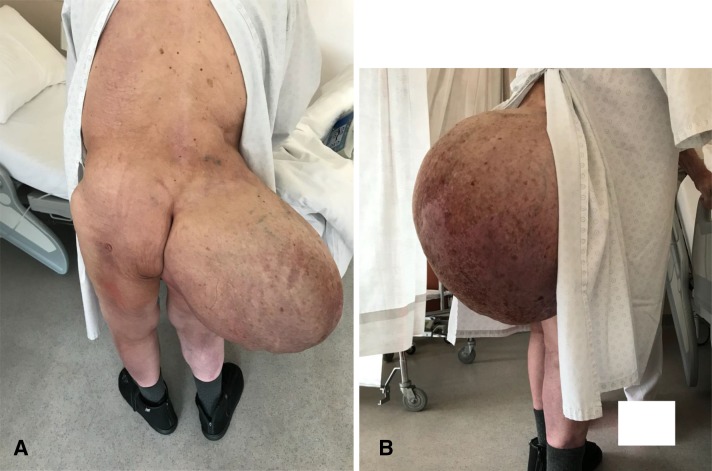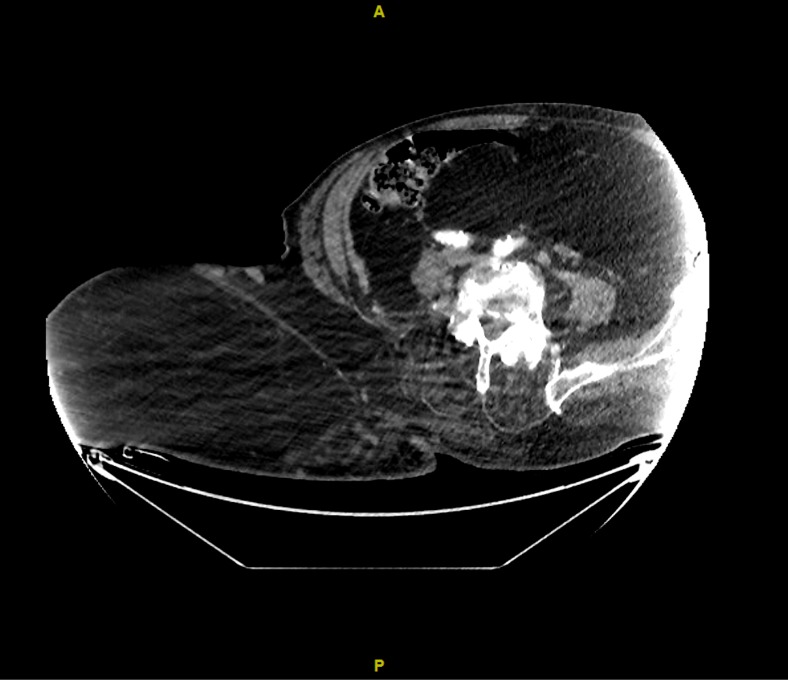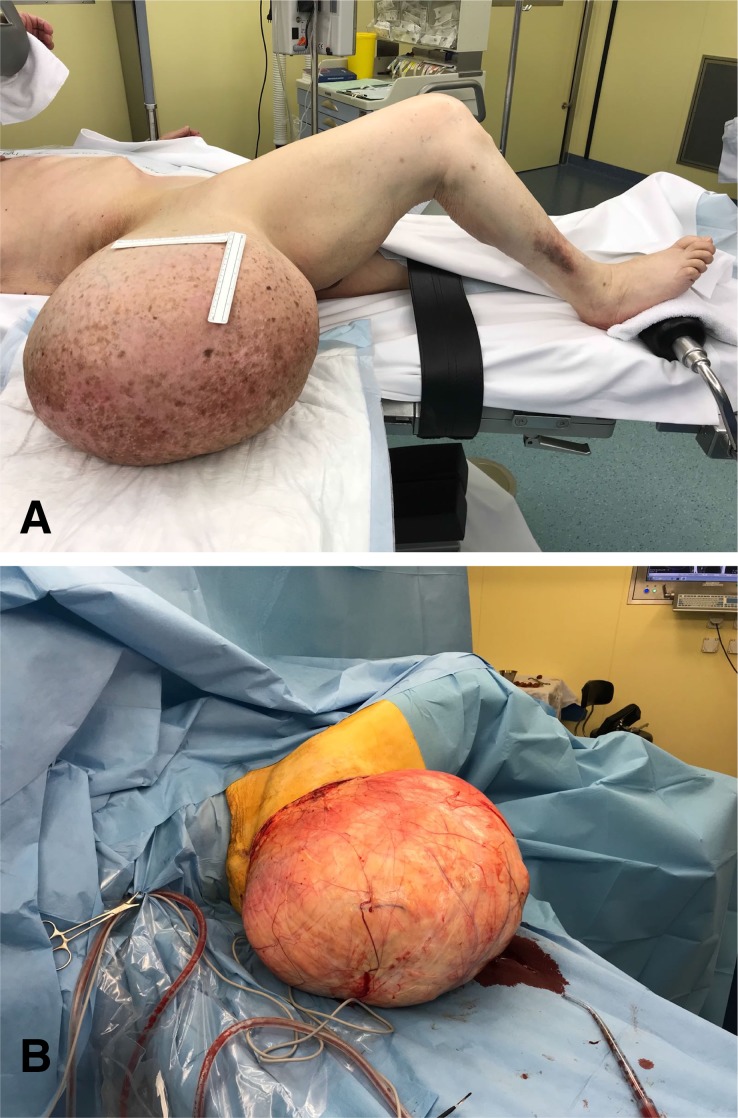Abstract
Surgical treatment of lipomas is typically only considered when they are painful or unsightly. We present the case of a massive hip lipoma; with this extreme case, we show that the global prolongation of life expectancy can lead to other indications of removal.
Keywords: general surgery, plastic and reconstructive surgery, dermatology
Background
Lipomas are benign and common soft-tissue tumours with many different clinical presentations. Surgical management can sometimes be tricky, and surgeons must keep in mind the potential risk of malignancy with large tumours.
Case presentation
We describe the case of a 90-year-old patient with a giant gluteal lipoma having evolved over more than 20 years. The patient was well aware of this slow-growing painless mass on his right hip but refused any treatment. He was addressed to our surgical consultation by his family doctor for lameness and unbalanced walking. (figure 1A, B).
Figure 1.
(A) Posterior view of the patient’s lipoma. (B) Lateral view of the patient’s lipoma.
Investigations
Even though a benign lipoma was clearly suspected, a CT scan was performed. However, the lesion was so large that it could not be scanned entirely (figure 2). The tumour-like lipoma seemed to be in contact with the sacrum, the tuber ischiadicum and the greater trochanter. Furthermore, there was a suspicion of an infiltration of the flexor’s muscles of the right leg. Vascularisation of the lipoma was mainly provided by an enlarged superior gluteal artery.
Figure 2.
CT scan of the right hip lipoma.
Treatment
After discussing the pros and cons of an intervention with the patient and his family, the decision was taken to remove the mass surgically. The patient was installed in a dorsal decubitus position (figure 3A). The operation resulted in the removal of a 30×60 cm 20 kg lipoma (figure 3B).
Figure 3.
(A) Dorsal decubitus surgical position. (B) Lipoma total dissection.
Outcome and follow-up
The pathology report confirmed that the tumour was benign. Skin was preserved in order to allow a functional reconstruction of the gluteal region. Wound management was simple, and follow-up was unremarkable. Additionally, the patient received intensive physiotherapy for walk recovery and after 5 weeks he could achieve completely independent walking.
Discussion
What makes this case interesting is the fact that even a benign pathology such as a lipoma progressed into a situation requiring delicate surgical management, both due to the technical aspect of the operation itself, and because of the patient’s advanced age.
With no difference in prevalence across genders and a 40–60 years old average age,1 lipomas are the most frequent benign soft-tissue tumours. Whether isolated or multiple, congenital or post-traumatic,2 lipomas are frequent in our daily routine; some studies mention the genetic implication in more than 50% of them.3 Even with minimal risk of malignant evolution, the first step of imaging should be ultrasonography,4 sometimes associated with MRI for large or deep tumours.5 Various treatments can be suggested for mechanical or aesthetic concerns. Surgery is the most appropriate treatment, associated with other techniques6 (suction, soft-tissue reconstruction, flap and so on).
Various pathologies imitating lipomas, such as lipomatosis or lipodystrophy, should be distinguished from it.7 The WHO gives a standard classification for all types of lipomas.8
Giant lipomas are a specific entity as their precise definition is only based on the general aspect of the tumour, with a specific size and weight cut-off given by Sanchez et al.9 In order for a lipoma to be called ‘giant’, the lesion must be at least 10 cm in one dimension or weigh a minimum of 1 kg. Based on recent literature, the case we report here is the second largest sub-cutaneous lipoma ever described (table 1).
Table 1.
Largest giant lipomas in French/English-language literature (>10 cm and >1000 g)
| Reference | Year | Localisation | Pathology | Size (cm)/weight (kg) |
| Current case | 2017 | Gluteal | Unknown | 30×60/20 |
| Emegoakor et al 10 | 2017 | Lower limb | Unknown | 22×17/?? |
| Mascarenhas et al 11 | 2017 | Gluteal | Liposarcoma | 17/?? |
| Guler et al 12 13 | 2016 | Back | Unknown | 38×22×21/3.575 |
| Grimaldi et al 14 | 2015 | Back | Lipoma | 36×40×24/5.75 |
| Dabloun et al 15 | 2015 | Back | Unknown | 25×25×18/?? |
| Silistreli et al 16 | 2004 | Back | Unknown | ??/12.350 |
| Martin et al 17 | 1928 | Neck | Unknown | ??/12.5 |
| Brandler et al 18 | 1894 | Back | Unknown | ??/22.7 |
? represents that others authors did not provide a number for this specific information.
Learning points.
Giant lipomas are above all aesthetics concerns but in advanced form a functional problem.
Benign tumours with low risk of malignant evolution.
Surgery as if aesthetic or functional disorders.
The transformation of a large lipoma (>10 cm) to a liposarcoma is rare.
Footnotes
Contributors: AL wrote the article; MM, FC and BE verified the analytical methods and supervised the findings of this work. All authors discussed the results and contributed to the final manuscript.
Funding: The authors have not declared a specific grant for this research from any funding agency in the public, commercial or not-for-profit sectors.
Competing interests: None declared.
Provenance and peer review: Not commissioned; externally peer reviewed.
Patient consent for publication: Obtained.
References
- 1. Inampudi P, Jacobson JA, Fessell DP, et al. Soft-tissue lipomas: accuracy of sonography in diagnosis with pathologic correlation. Radiology 2004;233:763–7. 10.1148/radiol.2333031410 [DOI] [PubMed] [Google Scholar]
- 2. Copcu E, Sivrioglu NS. Posttraumatic lipoma: analysis of 10 cases and explanation of possible mechanisms. Dermatol Surg 2003;29:215–20. [DOI] [PubMed] [Google Scholar]
- 3. Turc-Carel C, Limon J, Dal Cin P, et al. Cytogenetic studies of adipose tissue tumors. II. Recurrent reciprocal translocation t(12;16)(q13;p11) in myxoid liposarcomas. Cancer Genet Cytogenet 1986;23:291–9. 10.1016/0165-4608(86)90011-7 [DOI] [PubMed] [Google Scholar]
- 4. Kuwano Y, Ishizaki K, Watanabe R, et al. Efficacy of diagnostic ultrasonography of lipomas, epidermal cysts, and ganglions. Arch Dermatol 2009;145:761–4. 10.1001/archdermatol.2009.61 [DOI] [PubMed] [Google Scholar]
- 5. Fuchs A, Henrot P, Walter F, et al. [Lipomatous tumors of soft tissues in the extremities and the waist in adults]. J Radiol 2002;83:1035–57. [PubMed] [Google Scholar]
- 6. Al-basti HA, El-Khatib HA. The use of suction-assisted surgical extraction of moderate and large lipomas: long-term follow-up. Aesthetic Plast Surg 2002;26:114–7. 10.1007/s00266-002-1492-1 [DOI] [PubMed] [Google Scholar]
- 7. Delgado L, Ingen-Housz-Oro S. Maladies du tissu adipeux: lipomes, lipomatoses, lipodystrophies. EMC - Dermatologie 2011;6:1–9. 10.1016/S0246-0319(11)57953-1 [DOI] [Google Scholar]
- 8. Vilanova JC. WHO Classification of Soft Tissue Tumors Imaging of soft tissue tumors: Springer International Publishing, 2017:187–96. [Google Scholar]
- 9. Sanchez MR, Golomb FM, Moy JA, et al. Giant lipoma: case report and review of the literature. J Am Acad Dermatol 1993;28(2 Pt 1):266–8. 10.1016/S0190-9622(08)81151-6 [DOI] [PubMed] [Google Scholar]
- 10. Emegoakor CD, Echezona CN, Onwukamuche ME, et al. A report of two cases. Niger J Gen Pract 2017;15:46–9. [Google Scholar]
- 11. Mascarenhas MRM, Mutti LA, Paiva JMG, et al. Giant atypical lipoma. An Bras Dermatol 2017;92:546–9. 10.1590/abd1806-4841.20174447 [DOI] [PMC free article] [PubMed] [Google Scholar]
- 12. Righi A, Pantalone O, Tagliaferri G. Giant lipoma of the thigh: a case report. J Ultrasound 2012;15:124–6. 10.1016/j.jus.2012.02.010 [DOI] [PMC free article] [PubMed] [Google Scholar]
- 13. Guler O, Mutlu S, Mahirogulları M. Giant lipoma of the back affecting quality of life. Ann Med Surg 2015;4:279–82. 10.1016/j.amsu.2015.08.001 [DOI] [PMC free article] [PubMed] [Google Scholar]
- 14. Grimaldi L, Cuomo R, Castagna A, et al. Giant lipoma of the back. Indian J Plast Surg 2015;48:220–1. 10.4103/0970-0358.163074 [DOI] [PMC free article] [PubMed] [Google Scholar]
- 15. Dabloun S, Khechimi M, Jenzeri A, et al. Lipome géant du dos : à propos d’un cas. Annales de Dermatologie et de Vénéréologie 2015;142:S353 10.1016/j.annder.2015.04.133 [DOI] [Google Scholar]
- 16. Silistreli OK, Durmuş EU, Ulusal BG, et al. What should be the treatment modality in giant cutaneous lipomas? Review of the literature and report of 4 cases. Br J Plast Surg 2005;58:394–8. 10.1016/j.bjps.2004.09.005 [DOI] [PubMed] [Google Scholar]
- 17. Martin HS. Massive lipoma of the subcutaneous tissue of the back. J Am Med Assoc 1928;90:2013 10.1001/jama.1928.02690520025008 [DOI] [Google Scholar]
- 18. Brandler TI. Large fibrolipoma. Br Med J 1894;1:574. [Google Scholar]





